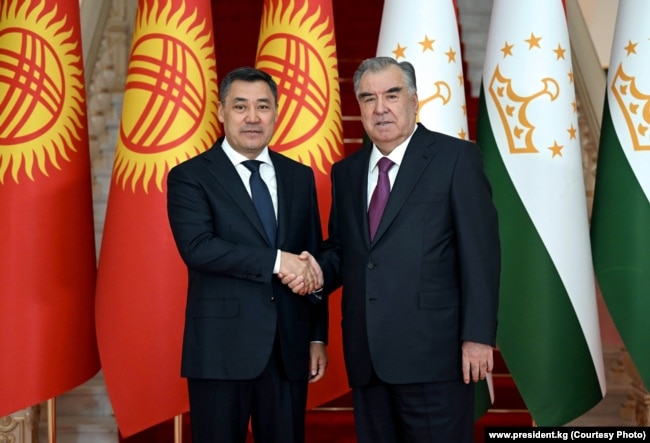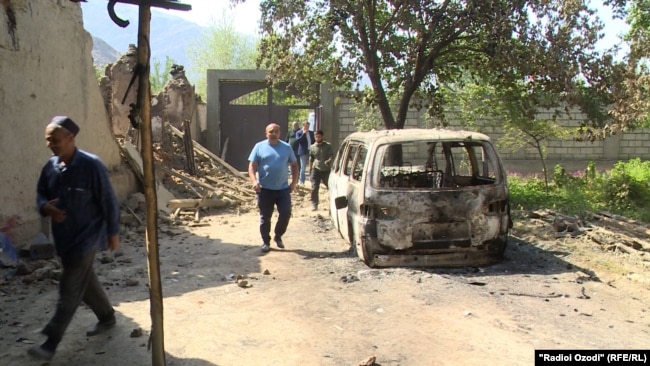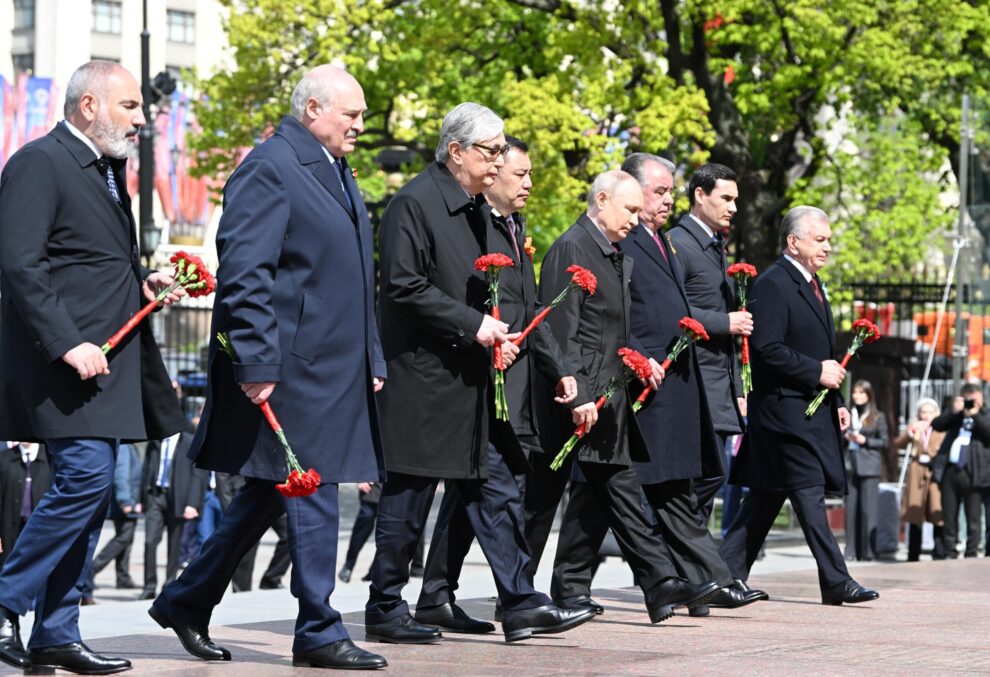On the first anniversary of Kyrgyzstan and Tajikistan’s deadliest border war, marked in September, irascible Kyrgyz national-security chief Kamchybek Tashiev aired his frustrations at the slow progress in talks aimed at demarcating the disputed frontier.
Tajikistan, said Tashiev, was making “territorial claims” against Kyrgyzstan in the talks.
“But our answer is that there should be no such claims,” Tashiev fumed, noting ominously that Kyrgyzstan had found “new documents” related to the border.
“Based on those, we know that many parts of Kyrgyzstan had been given to Tajikistan,” he claimed. “If [Tajikistan] does not renounce its territorial claims against Kyrgyzstan then we will legally present territorial claims to our neighbors.”
That brazen statement led observers of one of the longest-running border disagreements between two former Soviet republics bracing for the impact of a reply from Dushanbe.
Tashiev’s emergence as the powerful new head of Kyrgyzstan’s State Committee for National Security in 2020 coincided with a dramatic worsening of relations between the two countries.
Although conflicts between Kyrgyz and Tajik communities along the border occurred regularly before then, sometimes even involving soldiers, they remained largely local affairs.
But the “wars” of 2021 and 2022, by contrast, killed scores on both sides, left whole villages destroyed and — on both occasions — expanded the zone of the conflict.
Sure enough, Tashiev’s words didn’t go unheard in Tajikistan.
Kyrgyzstan’s ambassador was summoned by the Tajik Foreign Ministry, which warned that such comments could impair bilateral border talks.
Later that month, Tajik President Emomali Rahmon ordered the Defense Ministry to take control of several civilian airports in Tajikistan — including the Isfara airport near the Kyrgyz border.
But this time no bullets and bombs followed.
Instead, Rahmon and Kyrgyz counterpart Sadyr Japarov held talks on the sidelines of the United Nations General Assembly in New York City just days later and again the following month at a summit of the Commonwealth of Independent States (CIS) in Bishkek, with a focus on delimitation and avoiding a repeat of hostilities.

Fast forward to December and not only is 2023 likely to pass without major incidents on the border, but both sides are talking with increased optimism about seemingly concrete progress made in delimitation, with Japarov saying recently that the border might be fully agreed upon by the spring.
That is a significant change in tone.
Tokon Mamytov, a former deputy prime minister and security council secretary in Kyrgyzstan, told RFE/RL that the two governments deserve credit for “overhauling the template” in border talks.
If talks had traditionally become stuck on fixations with different Soviet-era maps — Tajikistan’s preferred boundaries date back to the 1920s while Kyrgyzstan’s are from the 1950s — now there is a “new approach” from the bilateral commission working on delimitation, Mamytov argued.
“They go to the place and look at the border. They ask people who live there about facts on the ground. In this way, the intergovernmental commission is turning agreements between the two heads of states into a reality. Communities living near the border will be able to feel safe again,” Mamytov said.
Is ’90 Percent’ Of The Border Agreed Upon?
It is impossible to discount another Tajik-Kyrgyz flare up along the border.
Nearly 17 months separated the “wars” of May 2021 and September 2022 and, in both cases, the escalation was remarkably rapid.
But few would have expected peace to last so long in the fall of last year.
In the immediate aftermath of the second, deadlier conflict, Kyrgyzstan canceled military training exercises on its territory for the Collective Security Treaty Organization (CSTO) — a Russian-led regional military bloc — that were scheduled for October 2022 by explaining that Kyrgyz citizens would not accept the presence of Tajik troops on Kyrgyz soil so soon after a conflict that claimed at least 80 Kyrgyz lives and displaced more than 100,000 people.
At talks involving Japarov, Rahmon, and Russian President Vladimir Putin in Kazakhstan’s capital, Astana, that same month, Rahmon conspicuously failed to greet Japarov.
But a year later and just two weeks after Tashiev aired his frustrations over the direction the talks were taking, both he and his Tajik colleague, Saimumin Yatimov, hailed the signing of Protocol 42. Tashiev said the document “provides a basis for resolving all border issues.”
Yatimov was almost as evocative, noting that the two countries were “aiming to reach a comprehensive and fundamental agreement” as quickly as possible.
There were few details then, but Yatimov was more specific when speaking after further talks on December 2, declaring that the question of a troublesome road linking Vorukh — an enclave of Tajik territory in Kyrgyzstan — and the Tajik border settlement of Khoja Alo was “practically solved.”
Then came the news that the countries had agreed on another 24 kilometers of the border after talks held in the Tajik town of Buston, near the Kyrgyz border.
But it was after talks in Kyrgyzstan’s southern region of Batken on December 12 that the two men claimed their countries had preliminarily agreed on more than 90 percent of their shared border.
That would be a significant achievement.
Only last year, around one-third of the approximately 975-kilometer frontier (Kyrgyz officials claim it is slightly shorter) was still not demarcated.
In an interview with RFE/RL, Dushanbe-based political analyst Sherali Rizoyon said incentives for an agreement were raised by a growing impulse in Central Asia toward regional integration and an uptick in diplomatic activity involving several outside powers.
“Whether on the bilateral or regional level, the problem of state borders prevents the countries of Central Asia benefiting from the new opportunities that are appearing today,” Rizoyon told RFE/RL. “Countries cannot afford to remain hostage to border issues for long — they need to restore mutually beneficial cooperation.”
The ‘Deterrent Component’ And Unclear Russian Role
The word “historic” is overused in Central Asian diplomacy, but it would definitely apply to any agreement between Kyrgyzstan and Tajikistan on their state border.
Although the dispute did not turn violent until independence, analysts note that Tajik and Kyrgyz opinions on where the border begins and ends have been at odds since 1924, when Tajikistan was still an autonomous territory inside the Uzbek Soviet Socialist Republic and the territory of modern-day Kyrgyzstan had a similar status inside the Russian Socialist Federative Soviet Republic.
That makes next year the 100th anniversary of the dispute — and as good a time as any to end it.
But if 2023 has proven a year of genuine progress on border talks, it comes on the back of the tremendous human and material price paid by the two poorest countries in Central Asia.

And a big part of that is the increasingly deadly weapons deployed in the last two conflicts, amid a mini-arms race that has seen Kyrgyzstan secure Turkish Bayraktar drones and Tajikistan receiving equivalent weapons from Iran.
Francisco Olmos, a senior researcher in Central Asian affairs at Spain’s GEOPOL 21 Center, noted the “deterrent component” in the Kyrgyz leadership’s boasts about their recently acquired Bayraktar drones while speaking on RFE/RL’s Majlis podcast in November.
The destructive power of the Bayraktar was also in evidence in last year’s clashes, according to Human Rights Watch (HRW), whose investigation published in May 2023 found that forces on both sides had “likely” committed war crimes against civilians.
In an interview with RFE/RL after the release of that report, HRW Senior Crisis and Conflict Researcher Jean-Baptiste Gallopin said the watchdog’s interviews with people on both sides of the border showed that local populations “are tired of these terrifying conflicts and are really yearning for peace.”
At the same time, local communities in Tajikistan’s Sughd Province and Kyrgyzstan’s Batken Province — the scene of most of the violence in recent years — will have their own opinions about what constitutes a good settlement.
Additionally, unrest in Kyrgyzstan over a landmark border agreement reached with Uzbekistan early this year suggests that selling a border agreement to the population is not always easy.
Yet another unknown is Russia, whose failure to prevent large-scale conflict between two of its military allies drew criticism of a Kremlin bogged down in its invasion of Ukraine. Also criticized was the CSTO — a security bloc sometimes framed as Moscow’s answer to NATO.
That trilateral meeting in October 2022 in Astana was more welcomed by Japarov — who unsuccessfully requested Putin’s intervention — than Rahmon, who later launched a tirade focused on Moscow’s shortcomings as a strategic partner.
Putin said after the talks that Russia had offered to retrieve some of its own archival Soviet-era maps to help resolve the dispute.
Since then, Russia has done almost nothing to suggest it is playing a mediatory role.
But on September 20, the Russian Foreign Ministry waded into the diplomatic fallout over Tashiev’s comments, warning against “harsh declarations” that it said could reverse the progress made on the border by the two countries.
“It should be remembered that armed conflicts in the post-Soviet space are beneficial primarily to the collective West, which has its own tendentious goals that have nothing to do with the real interests of Central Asian countries,” the ministry said.
Source: RFERL















